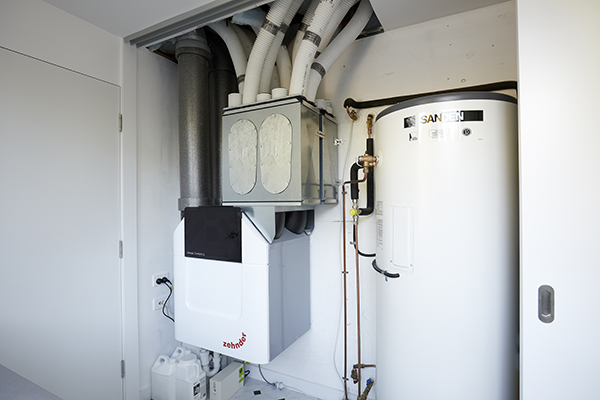Action Plan: What to Consider Before Buying HRV
Wiki Article
The All-Inclusive Overview to the Uses of Heat Recovery Ventilation in Modern Structures
Heat Recovery Ventilation (HRV) systems represent a considerable advancement in developing innovation (HRV Heat Recovery Ventilation). They supply an approach for exchanging stale indoor air with fresh exterior air while lessening energy loss. This method not just enhances indoor air quality but likewise adds to power efficiency in both domestic and industrial structures. Understanding the different applications and benefits of HRV can reveal its critical function in modern layout and sustainability initiatives. The ramifications of this innovation are worth checking out betterUnderstanding Heat Recovery Ventilation Equipments

Many modern buildings prioritize power efficiency, recognizing warmth recuperation air flow (HRV) systems is crucial for optimizing interior air top quality and lowering energy intake. HRV systems function by transferring warm from stagnant indoor air to inbound fresh air, effectively preserving comfortable interior temperatures while lessening energy loss. These systems consist of a warmth exchanger, fans, and ductwork that assist in the blood circulation of air. Throughout winter season, HRV devices capture and reuse heat from the outbound air, while in summer, they can assist cool incoming air. By constantly trading air, HRV systems also minimize moisture and the concentration of indoor contaminants. Appropriate setup and upkeep of HRV systems are crucial for their effectiveness and efficiency in improving overall building efficiency and comfort.
Benefits of Heat Recovery Ventilation
Heat recovery ventilation systems offer many benefits that boost both power effectiveness and indoor air quality in modern-day buildings. By capturing and recycling power from exhaust air, these systems significantly lower home heating and cooling prices, causing reduced energy usage. They maintain a stable circulation of fresh outdoor air, reducing the threat of indoor air toxins and irritants. This continuous exchange aids regulate humidity degrees, avoiding mold and mildew development and guaranteeing a much healthier living atmosphere. Furthermore, HRV systems contribute to sustainability goals by reducing overall carbon impacts. Their capability to optimize air flow without compromising thermal comfort makes them a valuable addition to contemporary structure design, promoting both financial and environmental advantages.Applications of HRV in Residential Buildings
As home owners progressively focus on energy effectiveness and indoor air high quality, the applications of heat healing ventilation (HRV) systems in residential buildings have ended up being more widespread. HRV systems are specifically beneficial in tightly secured homes, where maintaining fresh air circulation news is important for preventing wetness buildup and interior contaminants. They properly move warmth from outbound stagnant air to inbound fresh air, minimizing power expenses linked with cooling and heating. Additionally, HRVs can improve convenience degrees by regulating moisture and temperature level. They are additionally adaptable for numerous residential designs, including single-family homes and multi-unit buildings. On the whole, integrating HRV systems supports sustainable living methods while making sure a healthier indoor atmosphere for occupants.HRV in Business and Commercial Setups
In commercial and industrial settings, the implementation of warmth healing air flow (HRV) systems has become significantly vital for enhancing power efficiency and keeping air high quality. These systems successfully move heat from exhaust air to incoming fresh air, reducing the demand for extra heating or cooling. This not just reduces power expenses yet likewise adds to sustainability campaigns. Industries such as manufacturing, warehousing, and office complex benefit considerably from HRV systems, visit the site as they help regulate temperature and humidity degrees, guaranteeing a comfy and efficient setting. HRV systems help in eliminating pollutants and excess dampness, improving interior air top quality. As laws around air top quality end up being more stringent, the fostering of HRV innovation is most likely to grow, making it a vital part of contemporary industrial and industrial facilities.Future Trends in Heat Recovery Ventilation Technology

Frequently Asked Concerns
How Does Heat Recovery Ventilation Effect Indoor Air Top Quality?
Heat recovery ventilation substantially boosts interior air quality by continuously exchanging stale indoor air with fresh outside air while recovering power. This process reduces contaminants, maintains optimal moisture degrees, and assures a much healthier atmosphere for occupants.Can HRV Solutions Be Installed in Existing Buildings?
HRV systems can certainly be mounted in existing buildings. Retrofitting might call for modifications to ductwork and ventilation layouts, yet it substantially enhances power effectiveness and indoor air high quality, making it Find Out More a sensible option for older frameworks.What Upkeep Is Required for HRV Equipments?

Are There Details Climates Where HRV Is More Reliable?
Heat recovery ventilation systems are particularly reliable in climates with considerable temperature distinctions in between periods. These systems optimize energy effectiveness by recouping heat from exhaust air, making them optimal for both cold and reasonably cozy settings.Exactly How Do HRV Equipments Affect Power Costs?

Report this wiki page